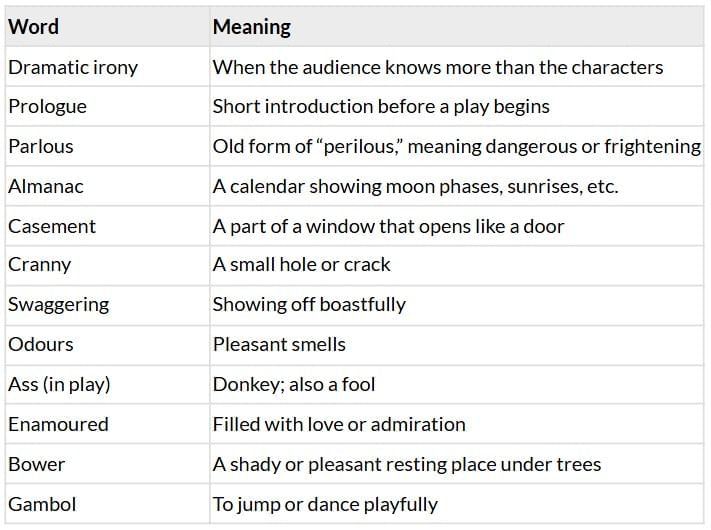The Play (play) Chapter Notes | Gul Mohar Class 7: Book Solutions, Summaries & Worksheets PDF Download
| Table of contents |

|
| About the Author |

|
| Detailed Summary |

|
| Moral / Message |

|
| Character Sketches |

|
| Vocabulary Table |

|
About the Author
William Shakespeare (1564–1616) was an English playwright, poet, and actor, often called the “Bard of Avon.” He wrote 39 plays, including comedies, tragedies, and histories, along with 154 sonnets. His works such as Hamlet, Macbeth, and A Midsummer Night’s Dream remain timeless, translated into every major language.
Detailed Summary
The scene is set in a forest where a group of ordinary artisans—Quince, Bottom, Snug, Flute, Snout, and Starveling—gather to rehearse a play called Pyramus and Thisby. They want to perform it as part of the entertainment for the duke’s wedding. None of them are professional actors, and their clumsy preparations make the entire situation very comical.
Quince, who is directing, assigns roles and explains how the green plot of land will be their stage. Bottom, full of confidence but limited knowledge, constantly interrupts with suggestions. He worries that the suicide of Pyramus will frighten the ladies in the audience, so he proposes a prologue explaining that the killing is not real and that he is only Bottom the weaver. 
Similarly, they worry that Snug, playing the lion, might scare the noblewomen. They decide that he should show his face through the costume and assure everyone he is not really a lion. They also debate how to represent moonlight and a wall (since Pyramus and Thisby meet by moonlight and speak through a crack in the wall). Their solutions are laughable—having an actor play Moonshine with a lantern, and another pretend to be Wall by holding his fingers apart to represent a gap.
While they rehearse, Puck, a mischievous fairy and servant of Oberon, secretly watches them. Amused by their simplicity, he decides to play a trick. He magically transforms Bottom’s head into that of an ass (donkey). The other artisans panic and run away in terror. Bottom, unaware of the change, thinks his friends are playing a prank to scare him. To prove his courage, he begins to sing loudly.
His singing awakens Titania, the fairy queen, who has been enchanted by Oberon’s magic flower. The spell makes her fall instantly in love with the first creature she sees—Bottom with his donkey’s head. She praises his voice and appearance, calling him wise and beautiful. She summons her fairy attendants—Peaseblossom, Cobweb, Moth, and Mustardseed—to serve him with fruits, dances, and flattery. Bottom responds in his typical foolish but cheerful way, joking about their names and acting as though he deserves all the attention.
This scene brings together Shakespeare’s use of dramatic irony, magic, and comedy. The audience knows Titania’s love is caused by enchantment, while she believes it is real. The artisans’ naïve rehearsal highlights human innocence and vanity, and Bottom’s transformation creates the central comic effect of the play.
Moral / Message
- The scene highlights how love can be irrational and blind, often ignoring reason or appearances.
- It also shows the humor in human vanity and overconfidence.
- Shakespeare suggests that both imagination and folly are part of human nature, and laughter often comes from taking ourselves too seriously.
Character Sketches
Bottom – A boastful but lovable weaver. Overconfident in his acting abilities, he constantly gives suggestions. After Puck transforms his head into that of an ass, he still remains cheerful, humorous, and fearless, symbolizing comic foolishness.
Quince – The carpenter and director of the play. He organizes the rehearsal and tries to manage the group. Though practical, he is often overpowered by Bottom’s confidence and ideas.
Snout, Snug, Starveling, Flute – Fellow artisans, each simple and inexperienced in acting. They add humor through their worries about frightening the audience or forgetting lines. Flute, playing Thisby, makes amusing mistakes in his delivery.
Puck – Oberon’s mischievous fairy servant. Playful and full of tricks, he enjoys confusing mortals. His magical prank on Bottom drives much of the comedy in this scene.
Titania – The fairy queen. Under the spell of Oberon’s magic flower, she falls in love with Bottom in his donkey-headed form. Her sudden, blind affection creates a contrast between her majestic status and Bottom’s foolishness.
Vocabulary Table

|
28 videos|56 docs|17 tests
|
FAQs on The Play (play) Chapter Notes - Gul Mohar Class 7: Book Solutions, Summaries & Worksheets
| 1. What is the significance of the title "The Play" in the context of the article? |  |
| 2. What are the key moral lessons presented in the play discussed in the article? |  |
| 3. Can you provide a brief character sketch of the main characters in the play? |  |
| 4. How does the vocabulary used in the play enhance its themes and characters? |  |
| 5. What are some common questions students might have about analyzing a play for their exams? |  |



















